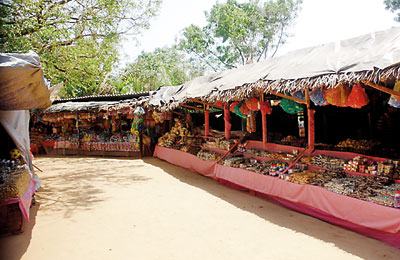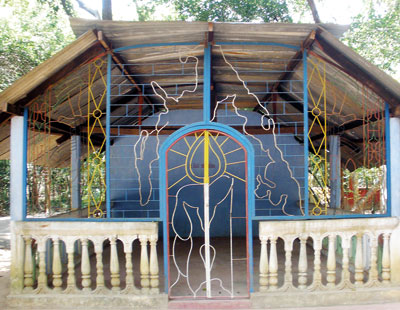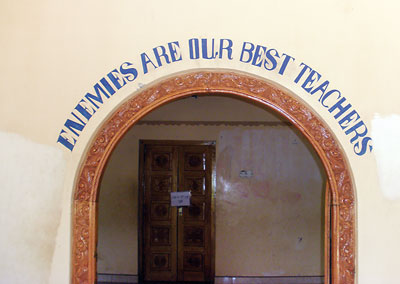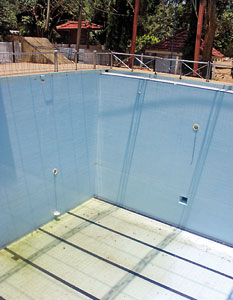A whole generation had grown up unable to visit the Northern and parts of the Eastern province of Lanka. The region was geographically so close, but politically so far, during the 26 years of civil War. It is therefore not surprising that the region which was out of bounds, holds a special interest to all Lankans.
A temporary truce opened up North-East for about a year around 2002, and I too did my first visit to Jaffna in 2003 May. From 2006 July, Eelam War IV closed North-East again till final liberation of the region in 2009 May.
When the A9 opened in 2010 January, there was a sudden rush of Lankans from the south to Jaffna, which at that time hardly had the infrastructure to support any tourism. Many of the LTTE sites such as Prabhakaran's home in Valvettithurai and the Martyrs cemetery in Koappaay, which I had visited in 2003, remained restricted. They were bulldozed in 2010 May, before a partial lifting of emergency rule. Removal of these modern constructs, ensured that tourists focus on the many important ancient archaeological sites, they must visit in Jaffna.
The region around Mullaitivu in the north-east of Lanka, where the last stages of the war was fought, remained out of bounds for everyone, except those who get special permission and an army escort. I was lucky to make such a visit in 2010 June.
In 2012 March, I had the opportunity to revisit Mullaittivu. I was curious to know what remained, of what I had seen in 2010, considering what had been done in Jaffna. To my surprise the Sri Lanka Army had gone at great lengths to preserve for now, all that they had captured from the LTTE.
 A large map in at the visitor information booth in Puthukkudiyiruppu
gave the "Important Locations of the Final Stage of the Humanitarian
Operation" in English and Sinhala. Most of the sites have been open to
the public since 2011 August, with no prior permission required. I was
told there were on average about 3,000 visitors each day from both
Sinhala and Thamil communities. School Holidays greatly increased the
number of visitors. One long weekend there were 400 bus loads.
A large map in at the visitor information booth in Puthukkudiyiruppu
gave the "Important Locations of the Final Stage of the Humanitarian
Operation" in English and Sinhala. Most of the sites have been open to
the public since 2011 August, with no prior permission required. I was
told there were on average about 3,000 visitors each day from both
Sinhala and Thamil communities. School Holidays greatly increased the
number of visitors. One long weekend there were 400 bus loads.
 Hawkers had got permission from the Army to setup stalls to sell
whatever they could. Selling from toys to local sweets, they are like
the stalls one sees outside most popular tourist destinations and
religious sites. The Army had provided a canteen to sell fast food,
soft drinks and beer. I was glad I had visited in 2010, before they
had become in-situ exhibitions. The camouflaged hideouts of the LTTE
leaders were now exposed for all to gawk at.
Hawkers had got permission from the Army to setup stalls to sell
whatever they could. Selling from toys to local sweets, they are like
the stalls one sees outside most popular tourist destinations and
religious sites. The Army had provided a canteen to sell fast food,
soft drinks and beer. I was glad I had visited in 2010, before they
had become in-situ exhibitions. The camouflaged hideouts of the LTTE
leaders were now exposed for all to gawk at.
 First stop was Prabhakaran's bunker. The 4-level underground bunker
with very thick walls and bullet proof doors was however empty. The
toilets inside were marked with "Danger - Please do Not use". The
functional use of each room was painted on the wall in Sinhala. The
Operations room, still had left the frame backing used for the maps. A
fire escape led out from the back in case of emergency. Outside were
the bullet proof sentry posts, shooting range, an underground vehicle
park, etc. Most interestingly just outside the compound was a Funeral
Parlor. A army tour guide clearly explained the outline design of the
metal gate. There was the map of claimed Eelam and a Burning candle
within the rest of the island, for future conquest. This description
had been given by Karuna Amman who had defected from the LTTE in 2004
March. I was told that furniture and other items I has seen in the
media, were found at Prabhakaran's bunker at Visuvamadu (midway on A35
between Mullaitivu and Kilinochchi).
First stop was Prabhakaran's bunker. The 4-level underground bunker
with very thick walls and bullet proof doors was however empty. The
toilets inside were marked with "Danger - Please do Not use". The
functional use of each room was painted on the wall in Sinhala. The
Operations room, still had left the frame backing used for the maps. A
fire escape led out from the back in case of emergency. Outside were
the bullet proof sentry posts, shooting range, an underground vehicle
park, etc. Most interestingly just outside the compound was a Funeral
Parlor. A army tour guide clearly explained the outline design of the
metal gate. There was the map of claimed Eelam and a Burning candle
within the rest of the island, for future conquest. This description
had been given by Karuna Amman who had defected from the LTTE in 2004
March. I was told that furniture and other items I has seen in the
media, were found at Prabhakaran's bunker at Visuvamadu (midway on A35
between Mullaitivu and Kilinochchi).
 Next stop was Sea Tiger chief Soosai's Safe House. The sign over his
front doorway read "Enemies are our best Teachers". He too had an
escape tunnel from inside a closet to the outside, which was still
usable. I manged to go through without a torch, which would have been
useful.
Next stop was Sea Tiger chief Soosai's Safe House. The sign over his
front doorway read "Enemies are our best Teachers". He too had an
escape tunnel from inside a closet to the outside, which was still
usable. I manged to go through without a torch, which would have been
useful.
 Next was the Terrorist swimming pool. Although only 83 feet in length,
the 22 feet depth is 50% more than even an Olympic size pool. It was
used to train sea tigers and has a glass observation port hle few
feet from the bottom. It had been enclosed within a camouflaged shed
which was now exposed. This site was next to the 68 division
headquarters with open access to Cafe Sixty Eight.
Next was the Terrorist swimming pool. Although only 83 feet in length,
the 22 feet depth is 50% more than even an Olympic size pool. It was
used to train sea tigers and has a glass observation port hle few
feet from the bottom. It had been enclosed within a camouflaged shed
which was now exposed. This site was next to the 68 division
headquarters with open access to Cafe Sixty Eight.
We next looked at 800 meter long defensive Bund at Puthumathalan which was 4-5 meters in height. It was breached by the security forces about a month before the end of the War, to release the civilians trapped within.
A open-air War Museum displayed captured naval equipment from experimental submarines to Human propelled Suicide torpedoes. Many of these items I had seen on display at military exhibitions.
The War Memorial had been opened in 2009 December. The Mark of Victory was inscribed in Sinhala, Tamil and English, on two very large granite slabs, which had stood at the entrance to the monument. They were now conspicuously missing reflecting the rift in the leadership that won the war. The support base with three holes was all that was left. A smaller slab with names of officers in only English remains behind the memorial .
The small strip of land around VellamullaVaikkal which saw the last days of the War, was still closed to public. A few piles of motorcycles, bicycles getting covered by foliage, and few rusting vehicles stacked on each other was all that remained. The large junk yard of vehicles had been scraped. Nature including migrant birds was reclaiming the area.
At a distance we saw a red Flag on a tall mast, which marks the spot at which Prabhakaran's body was found, next to the Nandhikkadal lagoon. The last stop was the rusting wreck of Farah-3 the Jordanian Merchant Ship captured by the Sea Tigers in 2006 December. While we were visiting that region with army escort, I saw a busload also visit. With over one percent of the Lankan population still working for the Military Forces, almost everyone knows someone to let them in.
Mullaitivu is worth a visit and it takes about 6 hours to site-see. After the probably short-term public curiosity dies out, a change in policy may have them Bulldozed, as it has happened in Jaffna. They are clearly not protected archaeological sites.
An edited version of this article First stop Prabhakaran's bunker By Kavan Ratnatunga appeared on the front page of the Plus Section in the SundayTimes of Sri Lanka on 2012 April 1st.